Mechanism still unclear, physiological causes possible
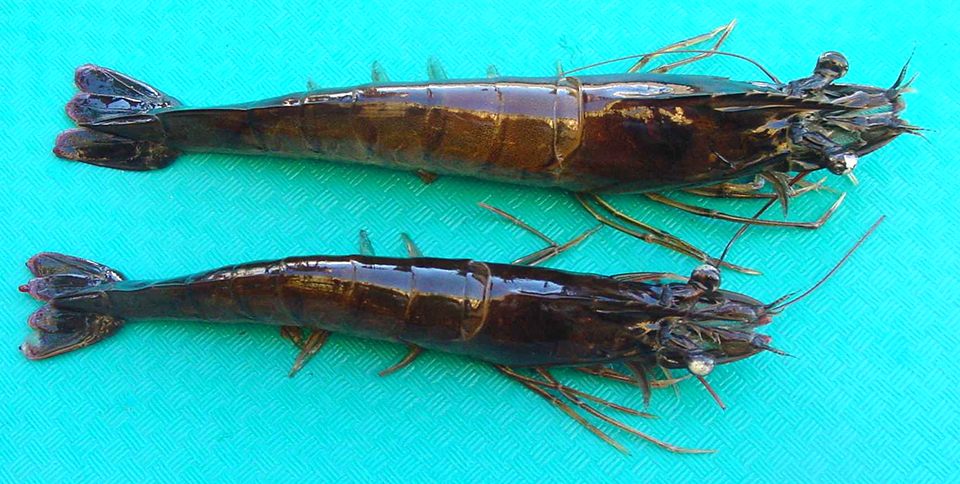
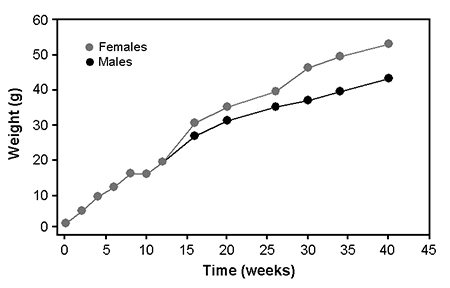
Sexual growth dimorphism occurs in many cultured aquatic species, including tilapia, catfish, and salmon, and has also been reported for cultured crustaceans. In mixed-sex culture, Macrobrachium spp. males typically grow faster and achieve a larger size than females, whereas the reverse is true for penaeid shrimp. Divergence of sex-specific growth rates for Penaeus monodon of 13 of 28 grams has been reported.
At the Oceanic Institute, the growth of Fenneropenaeus chinensis and Litopenaeus vannamei females diverges from males at approximately 10 grams and 20 grams, respectively (Figs. 1 and 2). Similar size-dependent sexual growth dimorphism has also been reported for P. semisulcatus, P. esculentus and Metapenaeus ensis.
Mechanism unknown
The mechanism by which females achieve a larger size than males is unknown. Sexual growth dimorphism may result from behavioral and/or physiological differences between males and females.
To investigate the role of behavioral factors on the growth of penaeid shrimp, four concurrent experiments were conducted at the Oceanic Institute to study the effects of shrimp gender and size on food handling time in adult L. vannamei.
Experimental setup
Three 3-square-meter replicate tanks were stocked at 16 shrimp per tank with either a random selection of males and females, females of large and small sizes, males of large and small sizes, or males and females of similar size. The experiment commenced when four 2.5 Χ 2.5-cm pieces of squid were introduced into the center of each tank. Total feeding time for each group was calculated.
Size, gender important
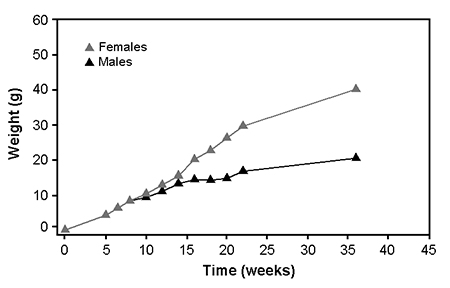
at the Oceanic Institute.
The mean feeding time for large shrimp was significantly longer than for small shrimp in both the all-male and all-female experiments (Fig. 3). For the random-selection and similar-size experiments, total feeding time for males was significantly longer than for females. In fact, the feeding time for males was almost four times longer than for females in the similar-size experiment. This was counterintuitive, since females typically grow faster and attain a larger size than males.
Both shrimp size and gender appeared to be important factors in food handling time for L. vannamei. Gender appeared to be more important than size, as males outcompeted females for food even when they were smaller than competing females. These results suggested that sexual growth dimorphism in L. vannamei is not the result of a greater competitiveness for food (a behavioral advantage) by females.
Similar results have been reported for P. monodon, and the causes of sexual growth dimorphism were investigated. As expected, female P. monodon grew faster than males, irrespective of whether the shrimp were grown in mixed-sex or monosex cultures. Although not statistically different, females in monosex tanks had higher feed intake rates and better feed-conversion ratios (physiological advantages) than males in monosex tanks.
Growth suppression
In mixed-sex culture, there was no evidence of male growth suppression by females, as the growth of males in both monosex and mixed-sex cultures was similar. However, there was indirect evidence of female growth suppression by males, as females in monosex culture grew 16 percent faster than those in mixed-sex culture. This could be the result of males having a competitive advantage in feed acquisition, as seen in L. vannamei.
This phenomenon has also been reported for Nile tilapia (Oreochromis niloticus). Typically, male O. niloticus grow faster than females in mixed-sex pond cultures. However, in individual rearing conditions with no behavioral interactions, female O. niloticus grow faster than males and have better feed-conversion ratios.
This suggests that in mixed-sex pond cultures, behavioral factors nullify the physiological advantage of females. Although there is some evidence to support this phenomenon in penaeid shrimp, more research is needed on the behavioral interactions between males and females.
Incentive for further research
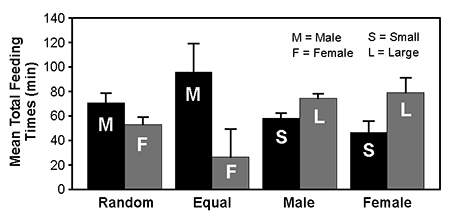
The growth superiority of female penaeid shrimp provides researchers with an incentive to investigate the potential for producing and culturing all-female populations. By removing slower-growing males, it is likely that the use of all-female shrimp could increase production in grow-out systems.
For example, the use of all-female populations could reduce the grow-out period for species that exhibit sexual growth dimorphism at a small size (such as F. chinensis), while allowing a larger harvest size without a major reduction in growth rate for species like L. vannamei that exhibit sexual growth dimorphism at a larger size. In addition to production benefits, monosex populations could provide seedstock and broodstock suppliers with a mechanism to protect their genetically improved germplasm.
Sex reversal
Despite the obvious advantages of monosex populations, little research has been devoted to sex reversal in penaeid shrimp. Selective breeding for skewed sex ratios will likely be ineffective, since heritability estimates for sex ratio in L. vannamei are not significantly different from zero.
Steroid hormones
Although the use of exogenous steroid hormones has proven effective for sex reversal in fish, results with penaeid shrimp have been mixed. Two studies with P. monodon have reported sex ratios skewed toward males and females with the use of methyltestosterone and estradiol, respectively. Trials with methyltestosterone and estradiol at the Oceanic Institute, however, proved ineffective.
Gland surgery
The most successful attempts at sex reversal in crustaceans have involved the implantation or removal of the androgenic gland. Androgenic gland hormone controls sexual differentiation in many crustaceans.
Implantation of androgenic glands into small sexually undifferentiated females has produced males in a number of crustaceans. Furthermore, the removal of androgenic glands in undifferentiated males has produced females. Although effective, these surgical methods are labor-intensive and costly, and further research will be needed before the mass production of monosex shrimp is possible.
Conclusion
The growth superiority of female over male penaeid shrimp is not the result of a competitive advantage in feed acquisition. The mechanism of sexual growth dimorphism in penaeid shrimp is still unclear, and more research is needed to investigate possible physiological causes.
The superior growth of females may warrant the culture of all-female populations for many species. However, efficient sex-reversal mechanisms still need to be developed.
(Editor’s Note: This article was originally published in the August 2002 print edition of the Global Aquaculture Advocate.)
Now that you've reached the end of the article ...
… please consider supporting GSA’s mission to advance responsible seafood practices through education, advocacy and third-party assurances. The Advocate aims to document the evolution of responsible seafood practices and share the expansive knowledge of our vast network of contributors.
By becoming a Global Seafood Alliance member, you’re ensuring that all of the pre-competitive work we do through member benefits, resources and events can continue. Individual membership costs just $50 a year.
Not a GSA member? Join us.
Authors
-
Dustin R. Moss
The Oceanic Institute
41-202 Kalanianaole Highway
Waimanalo, Hawaii 96795 USA -
Oscar L. Hennig
The Oceanic Institute
41-202 Kalanianaole Highway
Waimanalo, Hawaii 96795 USA -
Shaun M. Moss, Ph.D.
The Oceanic Institute
41-202 Kalanianaole Highway
Waimanalo, Hawaii 96795 USA
Tagged With
Related Posts
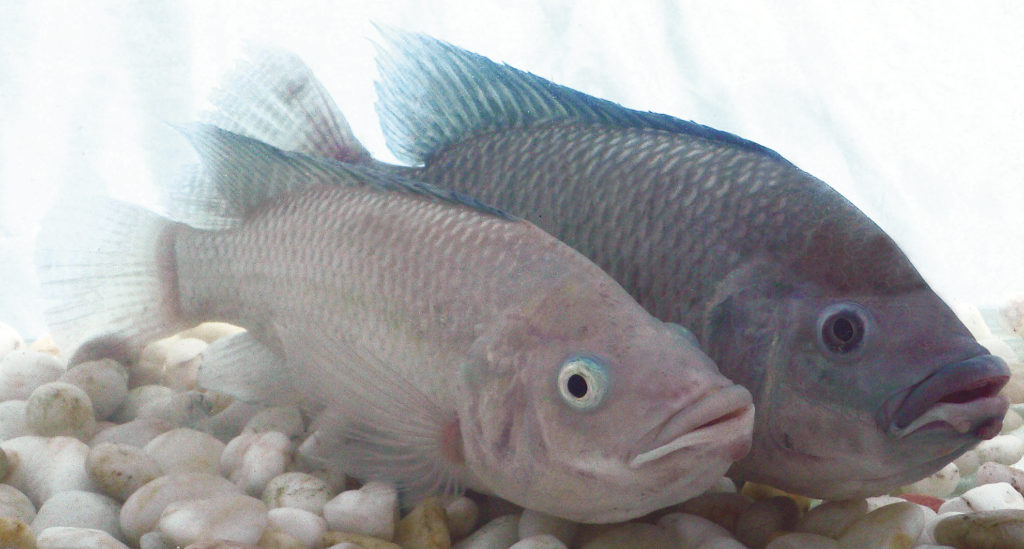
Health & Welfare
Hybrid tilapia outperform purebreds in seawater study
With interest in culturing tilapia in marine habitats increasing, producers must obtain tilapia capable of growing well in seawater. A study found that both pure-bred and hybrid tilapia performed better in freshwater than in water with high salinity.
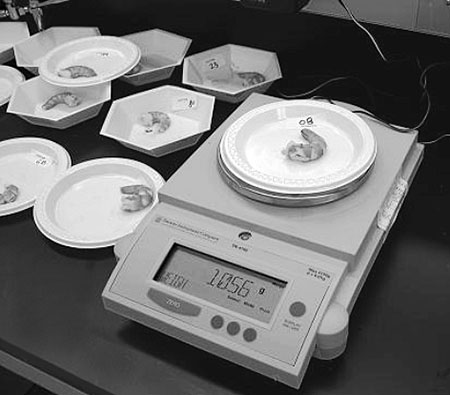
Health & Welfare
Potential of genetic selection for shrimp carcass, meat traits
Studies show variability for shrimp carcass and meat quality traits, especially fat quality. Selection for growth may lead to increase in yield.

Health & Welfare
A holistic management approach to EMS
Early Mortality Syndrome has devastated farmed shrimp in Asia and Latin America. With better understanding of the pathogen and the development and improvement of novel strategies, shrimp farmers are now able to better manage the disease.
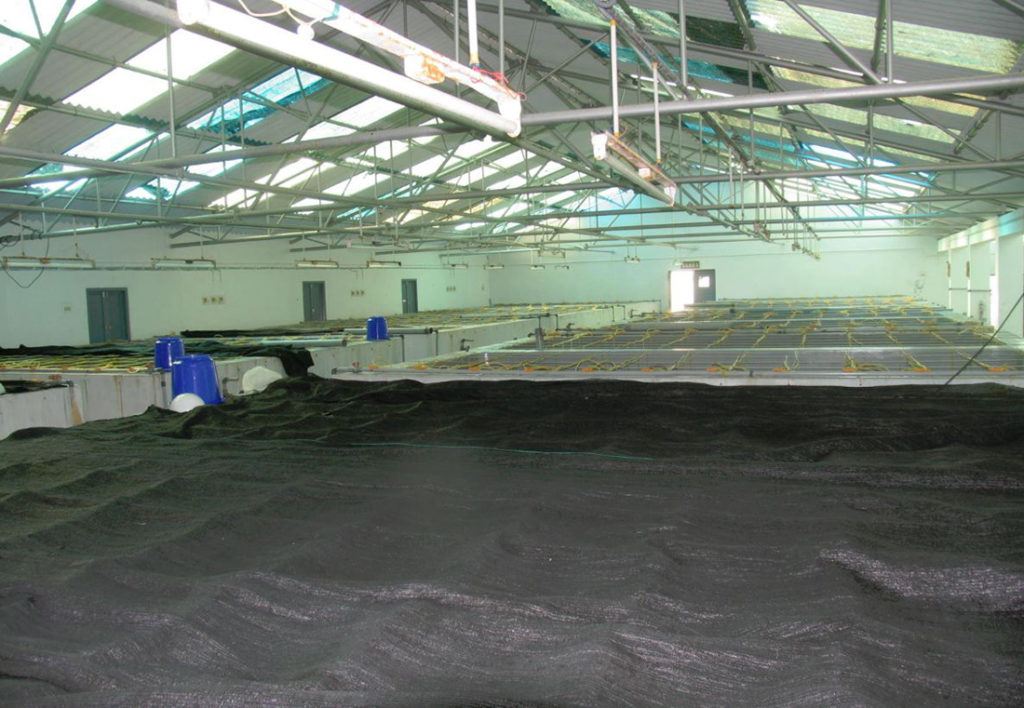
Health & Welfare
A study of Zoea-2 Syndrome in hatcheries in India, part 3
In this third and final part, authors present recommendations to help reduce the incidence of Zoea-2 Syndrome, which is not caused by any known infectious agents in P. vannamei hatcheries in India.


